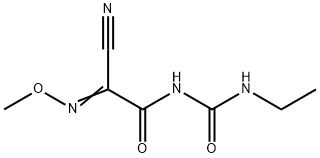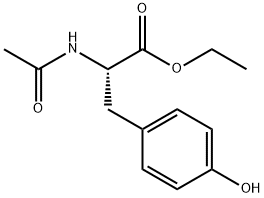CymoxanilSolutioninMethanol , 1000μg/mLinMethanol,uncertainty2% , 57966-95-7
Synonym(s):
1-(2-Cyano-2-methoxyiminoacetyl)-3-ethylurea
CAS NO.:57966-95-7
Empirical Formula: C7H10N4O3
Molecular Weight: 198.18
MDL number: MFCD00137381
EINECS: 261-043-0
| Pack Size | Price | Stock | Quantity |
| 1.2ml | RMB239.20 | In Stock |
|
| others | Enquire |
PRODUCT Properties
| Melting point: | 160-161° |
| Boiling point: | 335.48°C (rough estimate) |
| Density | 1.3841 (rough estimate) |
| vapor pressure | 1.5 x 10-4 Pa (20 °C) |
| refractive index | 1.6700 (estimate) |
| Flash point: | 100 °C |
| storage temp. | 0-6°C |
| solubility | DMSO: 100 mg/mL (504.59 mM) |
| pka | 9.7 |
| Water Solubility | 890 mg l-1 (pH 5), 780 mg l-1 (pH 7),
unstable at pH 9 at 20 °C |
| form | Solid |
| color | White to Light yellow to Light orange |
| Merck | 14,2765 |
| BRN | 2214018 |
| LogP | 0.590 |
| CAS DataBase Reference | 57966-95-7(CAS DataBase Reference) |
| NIST Chemistry Reference | Acetamide, 2-cyano-n-[(ethylamino)carbonyl]-2-(methoxyimino)-(57966-95-7) |
| EPA Substance Registry System | Cymoxanil (57966-95-7) |
Description and Uses
Cymoxanil is a cyanoacetamide fungicide. It inhibits the mycelial growth of 12 isolates of P. infestans with EC50 values of 0.27-0.57 μg/ml. Cymoxanil (5-100 mg/l) inhibits the growth of several strains of S. cerevisiae (IC50s = 8-25 mg/l) but not S. pombe, K. marxianus, P. anomala, or C. utilis. A spray application of cymoxanil (1 mg/mL) one day after inoculation of potato leaves with P. infestans and cucumber leaves with P. cubensis reduces blighted leaves by 79 and 60%, respectively. It is toxic to rats with an acute LD50 value of 3.8 mmol/kg. Formulations containing cymoxanil have been used to prevent fungal growth on crops and treat late potato blight in agriculture.
Agricultural fungicide.
Safety
| Symbol(GHS) |    GHS07,GHS08,GHS09 |
| Signal word | Warning |
| Hazard statements | H302-H317-H361fd-H373-H410 |
| Precautionary statements | P201-P273-P280-P301+P312+P330-P302+P352-P308+P313 |
| Hazard Codes | Xn;N,N,Xn |
| Risk Statements | 22-43-50/53 |
| Safety Statements | 36/37-60-61 |
| RIDADR | UN 3077 |
| WGK Germany | 3 |
| RTECS | AB5957000 |
| HazardClass | 9 |
| PackingGroup | III |
| HS Code | 29269090 |
| Hazardous Substances Data | 57966-95-7(Hazardous Substances Data) |
| Toxicity | For 80% formulations, LD50 orally in male rats: 1425 mg/kg; dermally in male rabbits: >3000 mg/kg. LC50 orally in bobwhite quails, mallard ducks: 2847, >10000 ppm. LC50 (96 hr) in bluegill sunfish, rainbow trout (ppm): 13.5, 18.7 (Klopping, Delp). |



